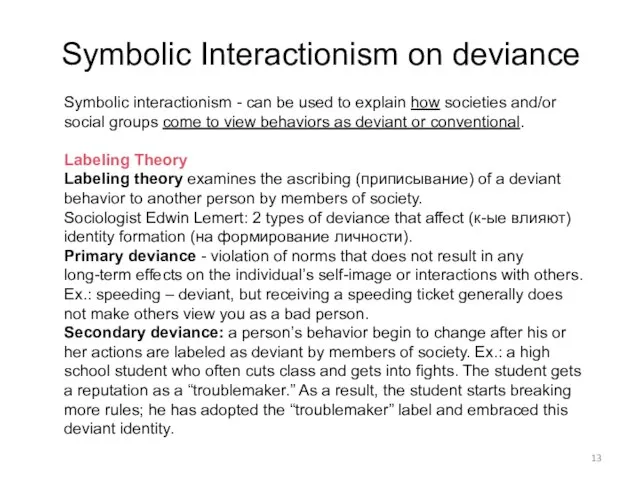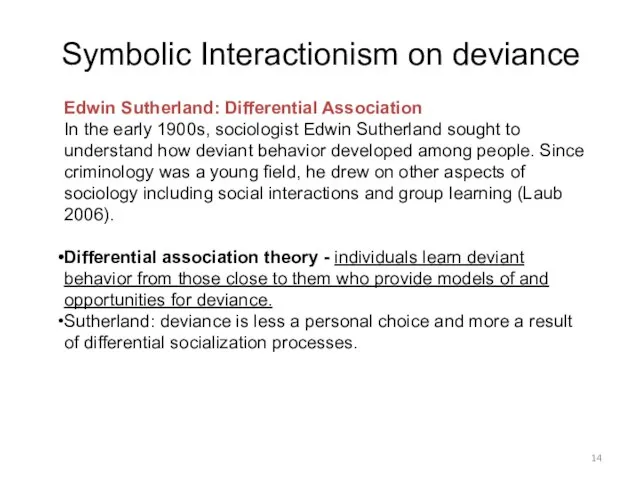Содержание
- 2. Learning Objectives Deviance and Control • Define deviance and explain the nature of deviant behavior •
- 3. Deviance and Control Deviance (отклонение от принятых норм и правил) William Graham Sumner: deviance - a
- 4. Deviance Behavior? Whether an act is deviant or not depends on society’s response (реакция общества) to
- 5. Deviance Behavior: Experiment +
- 6. Social Control What happens when a person violates (нарушает) a social norm? - A driver caught
- 7. The means (средства) of enforcing rules (усиления правил) – sanctions: positive and negative. Positive sanctions are
- 8. Social Control Sanctions, also: formal or informal: Informal sanctions emerge in face-to-face social interactions - wearing
- 9. Functionalist perspectives on deviance Functionalist approach: how the different elements of a society contribute (вносить вклад)
- 10. Functionalist perspectives on deviance Robert Merton: Strain Theory Strain theory - access (доступ к) to socially
- 11. Conflict theory on deviance Conflict theory: social and economic factors as the causes of crime and
- 12. Conflict theory on deviance C. Wright Mills: The Power Elite In his book The Power Elite
- 13. Symbolic Interactionism on deviance Symbolic interactionism - can be used to explain how societies and/or social
- 14. Edwin Sutherland: Differential Association In the early 1900s, sociologist Edwin Sutherland sought to understand how deviant
- 16. Скачать презентацию
Слайд 2Learning Objectives
Deviance and Control
• Define deviance and explain the nature of deviant
Learning Objectives
Deviance and Control
• Define deviance and explain the nature of deviant

• Differentiate between methods of social control
Theoretical Perspectives on Deviance
• Describe the functionalist view of deviance in society through two sociologist’s theories
• Explain how conflict theory understands deviance and crime in society
• Describe the symbolic interactionist approach to deviance, including labeling and other theories
Crime and the Law
• Identify and differentiate between different types of crimes
Слайд 3Deviance and Control
Deviance (отклонение от принятых норм и правил)
William Graham Sumner: deviance
Deviance and Control
Deviance (отклонение от принятых норм и правил)
William Graham Sumner: deviance

From picking one’s nose in public to committing murder
Deviance behavior is… ?
Depends on:
Location + Audience + Individual committing the act (Becker 1963).
Listening to your iPod…
on the way to class: acceptable
during your lecture: rude.
on the witness stand (место для дачи свидетельских показаний в суде) before a judge - may cause you to be held in contempt of court (неуважение к суду), and consequently fined (оштрафовать).
Norms vary (различаются) across culture&time ? notions of deviance change also. E.g.: taking the life of another (отнимать жизнь у другого)
- Peace: reprehensible (предосудительно)
War: ok + may actually be rewarded (вознаграждаться).
Слайд 4Deviance Behavior?
Whether an act is deviant or not depends on society’s response
Deviance Behavior?
Whether an act is deviant or not depends on society’s response

Слайд 5Deviance Behavior: Experiment
+
Deviance Behavior: Experiment
+

Слайд 6Social Control
What happens when a person violates (нарушает) a social norm?
-
Social Control
What happens when a person violates (нарушает) a social norm?
-

- A student who wears a bathrobe (банный халат) to class gets a warning (предупреждение) from a professor
- An adult belching loudly (взрослый человек, к. громко рыгает) is avoided (избегается).
All societies practice social control - the regulation and enforcement (соблюдение) of norms.
The goal of social control is to maintain social order (общественный порядок), an arrangement of practices and behaviors on which society’s members base their daily lives (ежедневная жизнь).
Слайд 7The means (средства) of enforcing rules (усиления правил) – sanctions: positive and
The means (средства) of enforcing rules (усиления правил) – sanctions: positive and

Positive sanctions are rewards given for conforming (соответствие) to norms. A promotion at work is a positive sanction for working hard.
Negative sanctions are punishments for violating norms. Being arrested is a punishment for shoplifting (кража в магазине).
Social Control
Слайд 8Social Control
Sanctions, also: formal or informal:
Informal sanctions emerge in face-to-face social interactions
Social Control
Sanctions, also: formal or informal:
Informal sanctions emerge in face-to-face social interactions

- wearing flip-flops (шлепки) to an opera may draw disapproving looks (неодобрительные взгляды)
+ helping an old man carry grocery bags (сумки с продуктами) across the street—may receive positive informal reactions, such as a smile or pat on the back (похлопывание по спине).
Formal sanctions - officially recognize and enforce norm violations.
- If a student violates his/her university’s rules, s/he might be expelled.
+ A soldier who saves a life may receive an official commendation (благодарность).
Слайд 9Functionalist perspectives on deviance
Functionalist approach: how the different elements of a society
Functionalist perspectives on deviance
Functionalist approach: how the different elements of a society

Émile Durkheim: The Essential Nature of Deviance
Deviance - a necessary part of a successful society. One way deviance is functional, is that it challenges (ставить под сомнение) people’s present (текущие) views (1893).
When deviance is punished, it reaffirms (вновь подтверждать) current (настоящие) social norms, which also contributes to society (1893).
Seeing a student given detention (оставление после уроков) for skipping class (за пропуск занятия) reminds other students that playing hooky (прогуливание) isn’t allowed and that they, too, could get detention.
Слайд 10Functionalist perspectives on deviance
Robert Merton: Strain Theory
Strain theory - access (доступ к)
Functionalist perspectives on deviance
Robert Merton: Strain Theory
Strain theory - access (доступ к)

From birth, we’re encouraged to achieve the financial success. However, a person may have the socially acceptable goal of financial success but lack a socially acceptable way to reach that goal.
5 ways that people respond to this gap between having a socially accepted goal but no socially accepted way to pursue (достичь) it:
1. Conformity: conform to the socially accepted means and not deviate.
2. Innovation: using of criminal or deviant means.
3. Ritualism: people lower their goals until they can reach them through socially acceptable ways.
4. Retreatism: retreat (отступать) and reject society’s goals and means. Some beggars (попрошайки) have withdrawn (отказываться) from society’s goal of financial success.
5. Rebellion: rebel (протестовать), replacing (заменяя) a society’s goals and means with their own. Terrorists or freedom fighters look to overthrow a society’s goals through socially unacceptable means.
Слайд 11Conflict theory on deviance
Conflict theory: social and economic factors as the causes
Conflict theory on deviance
Conflict theory: social and economic factors as the causes

Karl Marx: An Unequal System
Marx: two rigid (неподвижно закреплённый) social groups: the proletariat and the bourgeois.
Bourgeois - a small and wealthy segment of society who controls the means of production. Proletariat is composed of the workers who rely on those means of production for employment and survival.
Though Marx spoke little of deviance, his ideas created the foundation (основу) for conflict theorists who study the intersection (точка пересечения) of deviance and crime (отклонение от общ. норм и преступления) with wealth and power (богатство и власть).
Слайд 12Conflict theory on deviance
C. Wright Mills: The Power Elite
In his book The
Conflict theory on deviance
C. Wright Mills: The Power Elite
In his book The

Wealthy executives, politicians, celebrities, and military leaders often have access to national and international power, and in some cases, their decisions affect everyone (оказывают влияние на каждого) in society.
Because of this, the rules of society work in favor (в пользу) of a privileged few (небольшого кол-ва привилегированных лиц) who manipulate them to stay on top (манипулируют правилами, чтобы сохранить свое положение).
Power elites decide what is criminal and what is not, and the effects are often felt most by those who have little power.
Mills’ theories explain why celebrities such as Chris Brown and Paris Hilton can commit crimes with little or no legal retribution.
Слайд 13Symbolic Interactionism on deviance
Symbolic interactionism - can be used to explain how
Symbolic Interactionism on deviance
Symbolic interactionism - can be used to explain how

Labeling Theory
Labeling theory examines the ascribing (приписывание) of a deviant behavior to another person by members of society.
Sociologist Edwin Lemert: 2 types of deviance that affect (к-ые влияют) identity formation (на формирование личности).
Primary deviance - violation of norms that does not result in any long-term effects on the individual’s self-image or interactions with others. Ex.: speeding – deviant, but receiving a speeding ticket generally does not make others view you as a bad person.
Secondary deviance: a person’s behavior begin to change after his or her actions are labeled as deviant by members of society. Ex.: a high school student who often cuts class and gets into fights. The student gets a reputation as a “troublemaker.” As a result, the student starts breaking more rules; he has adopted the “troublemaker” label and embraced this deviant identity.
Слайд 14Edwin Sutherland: Differential Association
In the early 1900s, sociologist Edwin Sutherland sought to
Edwin Sutherland: Differential Association
In the early 1900s, sociologist Edwin Sutherland sought to

Differential association theory - individuals learn deviant behavior from those close to them who provide models of and opportunities for deviance.
Sutherland: deviance is less a personal choice and more a result of differential socialization processes.
Symbolic Interactionism on deviance
 Стандарт электронной услуги (СЭУ)
Стандарт электронной услуги (СЭУ) Честь или участь
Честь или участь Англия: сложный путь к величию и процветанию
Англия: сложный путь к величию и процветанию АКУШЕРСКИЙ ТРАВМАТИЗМ МАТЕРИ И НОВОРОЖДЕННОГО
АКУШЕРСКИЙ ТРАВМАТИЗМ МАТЕРИ И НОВОРОЖДЕННОГО  ФИПС (Россия) ЕПО Япония USPTO (США) JOPAL INSPEC РЖ ВИНИТИ БЕН РАН ВИНИТИ ГПНТБ Hiware Press ChemWeb Science Direct Glosary.ru Рубрикон Medterms.com.
ФИПС (Россия) ЕПО Япония USPTO (США) JOPAL INSPEC РЖ ВИНИТИ БЕН РАН ВИНИТИ ГПНТБ Hiware Press ChemWeb Science Direct Glosary.ru Рубрикон Medterms.com. Индивидуальный гамма-нейтронный дозиметр ДП-70МП с полевым колориметром ПК-56
Индивидуальный гамма-нейтронный дозиметр ДП-70МП с полевым колориметром ПК-56 Условности и упрощения, применяемые при выполнении машиностроительных чертежей. Инженерная графика
Условности и упрощения, применяемые при выполнении машиностроительных чертежей. Инженерная графика АИС Аптекарь 8.1 Выгрузка данных в ЕСФИ
АИС Аптекарь 8.1 Выгрузка данных в ЕСФИ Кондитерские сахаристые изделия ручной работы
Кондитерские сахаристые изделия ручной работы Витратомір повітря
Витратомір повітря Салават - прекрасный город
Салават - прекрасный город Презентация на тему Психологическая готовность детей к школе
Презентация на тему Психологическая готовность детей к школе Уважаемые родители!
Уважаемые родители! Виды прав на чужие вещи. Сервитуты: установление
Виды прав на чужие вещи. Сервитуты: установление  Растрова і векторна графіка
Растрова і векторна графіка Устройство аэрирования для очистки воды и стоков
Устройство аэрирования для очистки воды и стоков ПОЧЕМУ НЕОБХОДИМ ДУХОВНЫЙ РОСТ
ПОЧЕМУ НЕОБХОДИМ ДУХОВНЫЙ РОСТ Роль рыбопропускных и рыбозащитных сооружений в сохранении водных биологических ресурсов при эксплуатации плотин водохранилищ
Роль рыбопропускных и рыбозащитных сооружений в сохранении водных биологических ресурсов при эксплуатации плотин водохранилищ Современные методы селекции
Современные методы селекции Студия-Агентство «Party Time» - агентство событийного маркетинга
Студия-Агентство «Party Time» - агентство событийного маркетинга Правление Ивана Грозного
Правление Ивана Грозного Презентация на тему Генетическая связь между классами неорганических веществ
Презентация на тему Генетическая связь между классами неорганических веществ Становление методов архитектурного творчества
Становление методов архитектурного творчества Веселый урок о том, что вкусно и полезно
Веселый урок о том, что вкусно и полезно ISO 9001-2015 и требования к критериям бизнес-процессов
ISO 9001-2015 и требования к критериям бизнес-процессов Черепные нервы
Черепные нервы Моделирование ночной сорочки
Моделирование ночной сорочки Волженин Аверьян Михайлович
Волженин Аверьян Михайлович